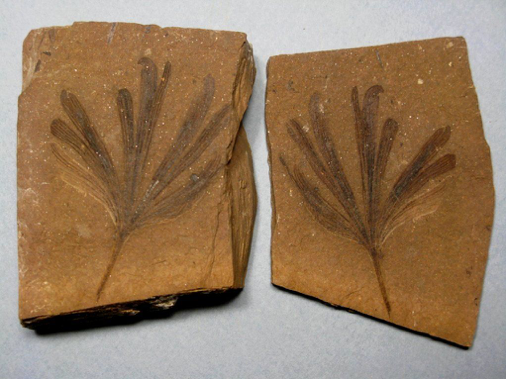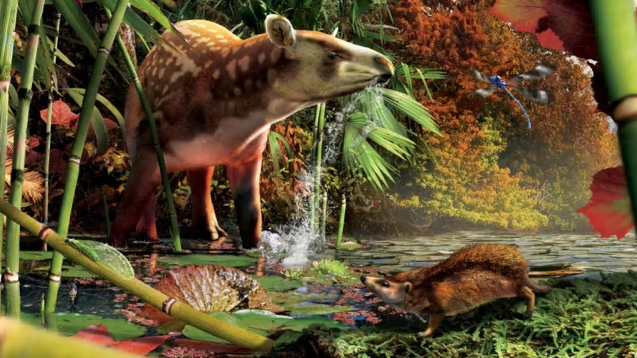VIU Science and Technology Lecture Series, February 20, 2019
David Greenwood, Department of Biology, Brandon University
by Lance Nordstrom
Professor Greenwood presented a lively and entertaining lecture about ancient plant life in the Eocene epoch 56 to 40 million years ago. At that time the earth was much warmer, with no polar ice caps. Although British Columbia was at about the same latitude as it is today, the fossil evidence suggests that the region was largely covered with tropical and subtropical forests. Even the most northerly lands of Ellesmere Island were home to rich forests of deciduous hardwoods and conifers. Vegetation resembling that of Georgia and the Carolinas spread over all land north of the Arctic Circle and extended south into the interior of British Columbia and Washington. Greenwood illustrated this with a slide showing the petrified stumps of Dawn redwood trees (Metasequoia) on Ellesmere Island, along with crocodilian fossils.
British Columbia has a superb fossil record from the Eocene, with numerous exposures throughout the interior of the province as well as elsewhere. Greenwood discussed several of the sites where he and his colleagues, especially his students, have searched for plant fossils. These sites are mainly in the Okanagan Highlands extending roughly 1000 km from northeastern Washington State to Driftwood Canyon in west-central British Columbia and preserving a rich Early to Middle Eocene plant and insect record, as well as of fish and mammals (e.g., Tillodont, Brontothere). The majority of collecting locations were clustered in southern British Columbia, and Greenwood described work done at several regional outcrops: Thomas Ranch (Princeton), One Mile Creek (Princeton), Falkland (between Kamloops and Vernon), Driftwood Canyon (Smithers), McAbee (between Cache Creek and Kamloops), and Whipsaw Creek (Princeton).

The Princeton Chert flora contain a mixture of taxa that includes both thermophilic tropical elements such as the palm (Uhlia), as well as those associated with temperate climates today including Abies (fir), Larix (larch), Betula (birch), Fagus (beech), and Ulmus (elm). Common taxa at Thomas Ranch include Ginkgo, Metasequoia (Dawn redwood), Sequoia (redwood), Abies, Pinus (pine), Acer (maple), Alnus (alder), Betula, Fagus, Sassafras (laurel family), Prunus (rose family), and Ulmus. One Mile Creek was noted for fossil remains of Tetracentron, a genus of flowering plant whose sole living species is Tetracentron sinense in southern China. The Falkland site contained fossils of Gingko, Pinus, Abies, Picea (spruce), and Sequoia, among others. Driftwood Canyon Provincial Park is known for its extremely well-preserved insects, but remains of two fossil birds, a fossil tapir, and a fossil hedgehog have also been found here. McAbee collections were dominated by leaves of Fagus, Ginkgo, and Sassafras, along with Trochodendron, a genus of flowering plants with one living species, Trochodendron aralioides, and six extinct species known from the fossil record. Whipsaw Creek was noted for evidence of insect herbivory in fossil plant leaves. Greenwood postulated that plants grown in elevated carbon dioxide atmospheres and warm temperatures tend to be nutritionally poorer, and well preserved Eocene fossil angiosperm leaves show considerable insect feeding damage to compensate for reduced nutrition. Consequently, insect herbivory can be used to investigate the net effects of increasing temperature and CO2 on plant–insect food webs over long time scales.

https://www.cbc.ca/news/technology/hedgehog-and-tapir-fossils-found-in-b-c-1.2699808
Greenwood emphasized that paleobotanists attempt to reconstruct ancient ecosystems and biological communities, as well as undertake taxonomic classification and phylogenetic relationships of individual specimens. He pointed out that changes observed in Eocene strata over tens or hundreds of thousands of years correspond to ecological time periods as opposed to evolutionary time scales. He discussed some measures of fossil plant diversity, showing that assemblages consisted of a mix of broadleaf evergreen understory and deciduous canopy trees. Fossil sites were generally restricted to lake and coal swamp sediments, so the Eocene plant communities investigated were likely located at low points in the landscape where water was not a limiting factor for plant growth. While some conifer foliage may have been transported to these lakes via streams from nearby high points in the landscape, it is thought that the fossil assemblages represent the floristic composition of local vegetative communities. It was suggested that these Eocene forests exhibited a mean annual temperature of about 12 deg. C. and mean annual precipitation of approximately 100 cm/year. Greenwood also talked about new techniques employed in paleobotanical research, such as computed tomography (CT) scans of rock samples to illuminate plant structures such as leaves in fine detail and in three dimensions.
To conclude his informative presentation, Greenwood pointed out that Eocene plants and animals represent a striking example of a high-latitude “greenhouse” world during the warmest interval in all of Cenozoic time. As concern about the current global warming trends are heightened, such fossils will play an ever-important role in our understanding and ability to predict the future impacts of global warming on Earth’s life and environments.
For more information, see: David R. Greenwood, S. Bruce Archibald, Rolf W. Mathewes, and Patrick T. Moss. 2005. Fossil biotas from the Okanagan Highlands, southern British Columbia and northeastern Washington State: climates and ecosystems across an Eocene landscape. Can. J. Earth Sci. 42:167–185.
